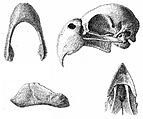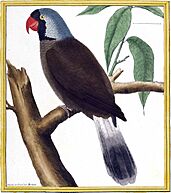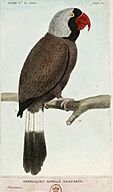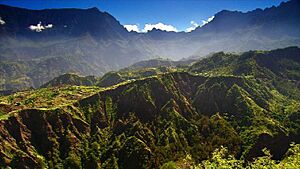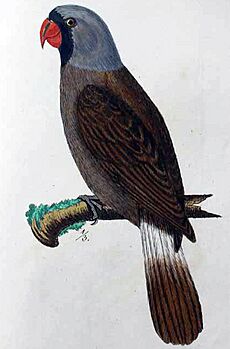Mascarene parrot facts for kids
Quick facts for kids Mascarene parrot |
|
|---|---|
 |
|
| 1893 illustration by John Gerrard Keulemans, based on the specimen in Muséum National d'Histoire Naturelle in Paris, one of two in existence | |
| Conservation status | |
| Scientific classification | |
| Genus: |
Mascarinus
|
| Species: |
mascarinus
|
 |
|
| Location of Réunion (encircled) | |
| Synonyms | |
|
List
Psittacus mascarin Linnaeus, 1771
Mascarinus madagascariensis Lesson, 1831 Coracopsis mascarina (Wagler, 1832) Mascarinus obscurus Bonaparte, 1854 Vaza mascarina (Schlegel, 1864) Psittacus madagascarensis (Finsch, 1868) Psittacus mascarenus Finsch, 1868 Coracopsis obscura (Gray, 1870) Psittacus madagascariensis (Pelzeln, 1873) Coracopsis mascarinus (Newton & Newton, 1876) Mascarinus duboisi Forbes, 1879 Mascarinus mascarin (Linnaeus, 1771) |
|
The Mascarene parrot or mascarin (Mascarinus mascarinus) was a type of parrot that is now extinct. It lived only on the island of Réunion in the western Indian Ocean. Scientists have debated where this parrot fits in the bird family tree. Recent genetic studies suggest it was related to the Psittaculini parrots, which are mostly found in Asia.
This parrot was about 35 centimeters (14 inches) long. It had a big red beak and long, rounded tail feathers. Its legs were red, and it had bare red skin around its eyes and nostrils. The bird also had a black "mask" on its face and partly white tail feathers.
What the living bird actually looked like in terms of body color is a bit of a mystery. Some old descriptions say its body and head were ash grey. They also mentioned that the white part of its tail had two dark feathers in the middle. However, stuffed specimens and other old descriptions show the body as brown and the head as bluish. This difference might be because the stuffed birds changed color over time from aging and being exposed to light. We know very little about how this bird lived in the wild.
The Mascarene parrot was first written about in 1674. Later, some live parrots were brought to Europe and kept in captivity. Scientists officially described the species in 1771. Today, only two stuffed specimens still exist, one in Paris and one in Vienna. It's not clear exactly when or why the Mascarene parrot became extinct. The last possible sighting was in 1834, but this is uncertain. It's more likely the species died out before 1800, or even earlier.
Contents
Discovering the Mascarene Parrot
The Mascarene parrot was first mentioned by a French traveler named Sieur Dubois in his travel book in 1674. After that, it was only described a few more times while still alive. At least three live parrots were brought to France in the late 1700s and kept as pets. Two of these were described while they were still alive.
Today, there are only two stuffed Mascarene parrot specimens left. One is in the Muséum National d'Histoire Naturelle in Paris, and the other is in the Naturhistorisches Museum in Vienna. The Vienna specimen was bought in London in 1806. There was also a third stuffed specimen around the year 1800, but it is now lost.
The Swedish zoologist Carl Linnaeus officially described the Mascarene parrot in 1771. He gave it the scientific name Psittacus mascarinus. The name "mascarin" was first used by a French zoologist in 1760, but not as a scientific name. The name refers to the Mascarene Islands, which were named after their Portuguese discoverer, Pedro Mascarenhas.
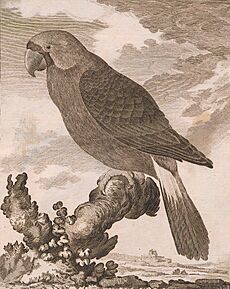
Some early writers thought the Mascarene parrot came from Madagascar. This idea led the French naturalist René Primevère Lesson to give it another name, Mascarinus madagascariensis, in 1831. His new genus name, Mascarinus, became widely accepted. When an Italian zoologist combined it with the earlier specific name in 1891, the name became Mascarinus mascarinus. This is a tautonym, meaning both parts of the scientific name are the same.
Understanding its Family Tree
Scientists have long wondered how the Mascarene parrot is related to other birds. There have been two main ideas since the mid-1800s. Some thought it was related to the Coracopsinae parrots (from Africa) because of its dark feathers. Others believed it was related to the Psittaculinae parrots (from Asia) because of its large red beak, which is a common feature in that group.
Even though we don't know much about most extinct parrots from the Mascarene Islands, their subfossil remains show they had similar features. These included larger heads and jaws, smaller chest bones, and strong leg bones. A scientist named Julian Hume believed they all came from the Psittaculini group. He thought this because of their body shapes and because Psittacula parrots have spread to many isolated islands in the Indian Ocean.
During the Pleistocene period, sea levels were lower. This made it easier for animals to travel to the Mascarene Islands from other places. Scientists think that Psittaculini parrots might have arrived in the area many times. Réunion Island is 3 million years old, which is enough time for new types of animals to develop. However, a huge volcano eruption between 300,000 and 180,000 years ago likely wiped out most of the unique animals on the island. So, most of the birds and animals living there recently probably came from Africa or Madagascar after this event. If the Mascarene parrot had developed into its own unique type on Réunion before the eruption, it would have been one of the few survivors.
In 2011, a genetic study looked at the Paris specimen. It suggested that the Mascarene parrot was related to the lesser vasa parrot from Madagascar. This meant it was not related to the Psittacula parrots. The study also said the Mascarene parrot's family line split off 4.6 to 9 million years ago, before Réunion Island was even formed. This would mean it must have evolved somewhere else. However, other scientists pointed out that the sample might have been damaged.
Then, in 2017, a new genetic study looked at the Vienna specimen. This study found that the Mascarene parrot was indeed part of the Psittacula group, just as Julian Hume had suggested. It was closely related to the extinct Seychelles parakeet and Asian types of the Alexandrine parakeet. This means the Mascarene parrot likely came from an ancient group of Alexandrine parakeets that flew from Asia to the Mascarene islands across the Indian Ocean. The researchers thought the 2011 study might have had mixed up DNA samples.
The pictures below show how the Mascarene parrot was placed in the bird family tree by the 2011 and 2017 DNA studies:
|
Kundu and friends, 2011:
|
Podsiadlowski and friends, 2017:
|
In 2019, some scientists suggested that the Psittacula genus should be split into several smaller groups. This would help keep the Mascarene parrot in its own genus, Mascarinus, while still showing its close relationship to Psittacula parrots. A 2022 study confirmed these relationships. It suggested that these parrots first appeared in the Australo–Pacific region. Then, the ancestors of the Psittacula and Mascarinus parrots were the first of their kind to reach Africa. From there, they traveled to the Mascarene Islands.
What the Mascarene Parrot Looked Like
The Mascarene parrot was about 35 centimeters (14 inches) long. Its wing was about 21.1 cm (8.3 in), and its tail was about 14.4 to 15.2 cm (5.7 to 6.0 in) long. It had a large red beak and a black, velvety mask on the front of its head.
There are different ideas about the color of its body, wings, tail, and head. In 1674, Dubois described live parrots as "petit-gris," which is a dark blackish grey or brown color. In 1760, a description based on a captive bird said its head and neck were light grey. Its back, chest, belly, and wings were very dark grey. The tail feathers were dark grey, with a little white at their base. The eyes were surrounded by bright red bare skin, and the beak was also red.
Later, many authors described the body as brown and the head as bluish, based on stuffed specimens. This became the common idea of what the bird looked like. However, live birds were never described with these colors. Scientists now think that the stuffed birds changed color over time because of aging and light exposure. Grey and black colors can turn brown. The two existing Mascarene parrot specimens also look different from each other. The Paris specimen has a grayish-blue head and a brown body. The Vienna specimen is pale brown all over.
Early colored drawings of the Mascarene parrot also caused confusion. A plate from 1779 by François-Nicolas Martinet showed the bird as brown with a purplish head. The colors in these drawings vary a lot because different artists hand-colored them. This means the body could be anything from chestnut brown to grayish chocolate. Martinet's drawing might have been based on the Paris specimen.
Life and Habitat
We know very little about how the Mascarene parrot lived in the wild. Since several were kept alive in captivity, it probably wasn't a picky eater. The Vienna specimen was partly white, which might have happened because it didn't get enough of the right food while in captivity. In the 1700s, people didn't know much about what parrots needed to eat. This parrot might not have gotten enough of a certain amino acid called tyrosine, which birds need to make dark colors in their feathers.
In 1705, a French mapmaker named Jean Feuilley described the parrots of Réunion. He said they got fat during certain seasons:
There are several sorts of parrot, of different sizes and colours. Some are the size of a hen, grey, the beak red [Mascarene parrot]; others the same colour the size of a pigeon [Mascarene grey parakeet], and yet others, smaller, are green [Réunion parakeet]. There are great quantities, especially in the Sainte-Suzanne area and on the mountainsides. They are very good to eat, especially when they are fat which is from the month of June until the month of September because at that time the trees produce a certain wild seed that these birds eat.
The Mascarene parrot might have also lived on Mauritius island. This is because a traveler in the 1600s mentioned "russet parrots" there. It's possible, as Réunion and Mauritius share some animals. However, no fossil evidence has been found on Mauritius yet.
Many other unique animals on Réunion became extinct after humans arrived. Humans changed the island's ecosystem. The Mascarene parrot lived alongside other recently extinct birds like the hoopoe starling and the Réunion ibis. Extinct reptiles on Réunion include the Réunion giant tortoise.
Why the Mascarene Parrot Disappeared
Out of about eight parrot species unique to the Mascarene Islands, only the echo parakeet of Mauritius is still alive. The others likely died out because of too much hunting and deforestation (cutting down forests).
The exact reason and date of the Mascarene parrot's extinction are not clear. In 1834, a German zoologist named Carl Wilhelm Hahn wrote about a live Mascarene parrot owned by King Maximilian I Joseph of Bavaria. The bird must have been very old. Hahn claimed his drawing was based on this bird. The IUCN Red List (a list of endangered species) accepts this 1834 account as the last time a live specimen was mentioned.
However, people started questioning Hahn's story as early as 1876. His drawing seems to be copied from an earlier drawing by François-Nicolas Martinet, made at least 50 years before. Also, when King Maximilian died in 1825, his collection was sold, but no Mascarene parrot was listed. Hahn didn't say when he actually saw the bird, so it could have been long before 1834. Because the drawing was copied and no stuffed bird from this time exists, Hahn's story is doubtful. He might have based it on other sources or just rumors.
If we don't count Hahn's story, the Mascarene parrot probably became extinct before 1800. The last reliable mention of wild parrots on Réunion is from the 1770s. It's thought that the Mascarene parrot died out in the wild while some captive birds still lived in Europe. In the 1790s, a French naturalist said the bird was rare and he had seen three in France.
One of the last clear descriptions of live Mascarene parrots is from 1784. It was written by Mauduyt, based on captive birds:
The Mascarin is found at Ile Bourbon [Réunion]; I have seen several alive in Paris, they were rather gentle birds; they had in their favour only that the red beak contrasted agreeably with the dark background of their plumage; they had not learnt to talk.
Unlike Feuilley's claims, Dubois said the Mascarene parrot was not good to eat. This might be why visitors to Réunion mostly ignored it. It was the last of Réunion's native parrots to become extinct. The only other unique bird on Réunion that disappeared after the Mascarene parrot was the hoopoe starling, in the mid-1800s.



